
None of the babies have arrived yet (which is good because they are not due for another six weeks) so they make a cheerful pile of miniature jumpers:

The top two are for my secretary, who knows that she is having another boy; the third one down is for a colleague who is having a surprise; and the bottom one, well who knows who that's for, the next person to have a girl probably.
So, seven jackets later, here are my top tips:
1. The Mitres (cue background scary sawing style noise!). Not as scary as they seem. The pattern starts off my working two mitred corners, one at each end so that you start to form two right angles in the knitting:

You could just count each row to the mitre, then slip, k2tog and psso but if you spread the corner out you can read the knitting and avoid the need to count:
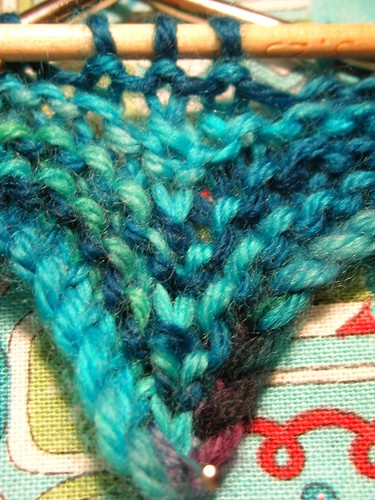
This picture shows the three central stitches at the corner. These are the three that will become one to form the corner. How do you find them? Look carefully, can you see that the vertical column of central stitches is 'wearing a scarf'?
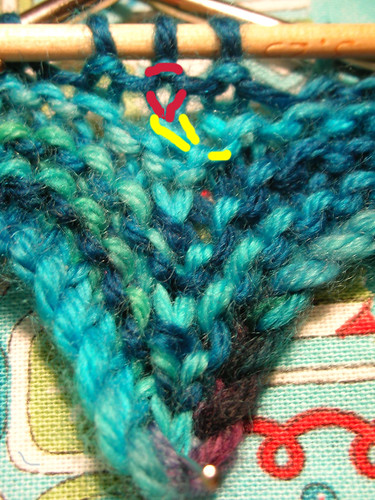
This picture shows it more clearly. The red stitch runs straight up the corner, and instead of the yellow stitch running directly underneath it, its tail flies off to the side - think of stereotypical illustrations of snowmen and you'll see why I call it a scarf. The yellow scarf will point to the red stitch, and then you have your centre point.
Slip the first stitch:
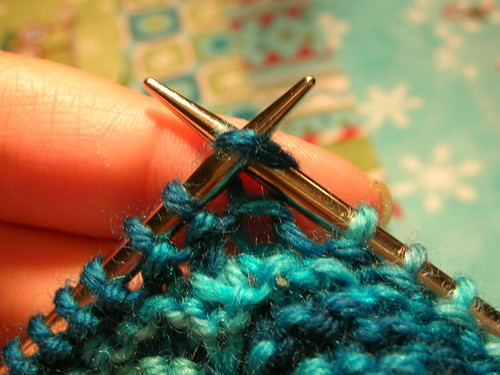
Knit the next two together:
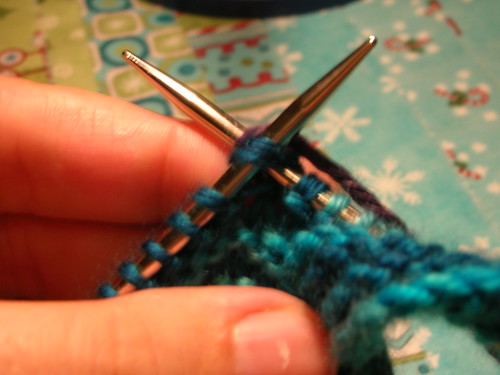
And pass the first slipped stitch over the top (that is just the one stitch coming over, the yarn was a bit splitty)
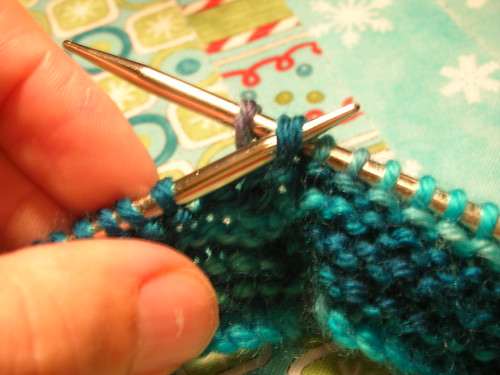
And there you go, one mitred corner:

Just rinse and repeat until you have finished the decreases.
2. Increases: the original EZ pattern suggests increasing by a backwards loop cast on. Although several pattern notes have suggested using a raised bar increase instead I've found the backward loop to be practically invisible in garter stitch so I do as the pattern suggests. The backward loop is exactly as it sounds; make a loop as if you were going to make a slip knot and then slide the loop onto the needle, with the live end of the yarn towards the stitches already on the needle. It's harder to describe than it is to so, if in doubt, if you pick up the needle and hold it point down a backwards loop will stay put but a loop de loop will fall off.
When you start increasing out again at the mitre lines I find it easiest to place a marker before the centre stitch. Then all you need to do is m1, slip marker, k1, m1.
3. Increases after five ridges: on a right side row I work (k3, m1) until the last stitch before the mitre, k1, work the mitre, section between and the other mitre, then k1, (m1, k3).
4. Increases for back fullness: I work these on the wrong side row after I get to the correct stitch count. Knit across until you have knit the second newly made stitch then work: (k5, m1) x 5, k4, (m1, k5) x 5.
5. Work across 90 sts: the 90 stitches runs from on centre line of a mitre to the other. When you pick up stitches and start working across the whole back again, the stitches to mark are the 'corners' of the 90st back-and-forth block.
6 Buttonholes: k6, (yo, k2tog, k6) x5, k1, m1, k1, m1, knit to next mitre centre line, m1, k1, m1, k1, (k6, k2tog, yo) x 5, k6.
Even if you know what variety of baby is expected it is so easy to sew up the extra buttonholes and sew the buttons on on top, and it avoids all the hassle of trying to line everything up.
7. If the yarn which you are working with is not hugely variegated you can oversew the shoulder seams, rather than mattress stitch them, for a flat seam so that nothing could possibly rub on the baby. I oversewed the pink baby and the rainbow baby and mattress stitched the other two. You can't tell unless you look.
8. Choosing the buttons is one of my favourite parts
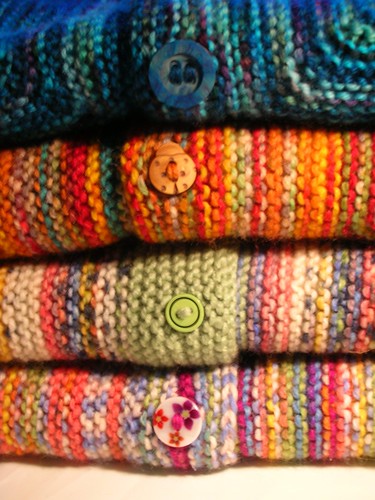
9. At a rough guess, a BSJ for a newborn takes 100g of DK weight wool. In these pictures we have Colinette Cadenza, Reqia Square Colour 6 ply, Some Opal Something, Debbie Bliss Baby Cashmerino and some more Regia Square. They are all machine washable.
10. This pattern is beautiful, easy and magical. Go and knit one now.
On the other side of the coin we have a contender for 'Now you see it, Now you don't':
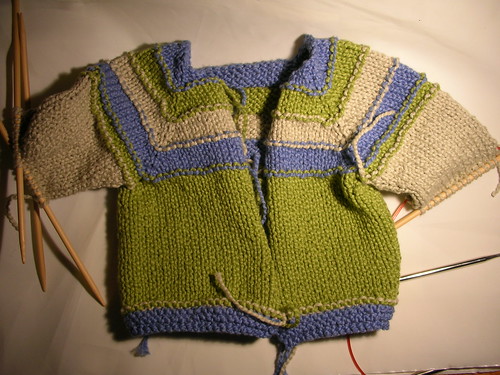
It is an attempt at the Super Natural Stripes jacket, but a combination of I have much less yarn/ it takes much more yarn than I thought has given some oddly eclectic stripes and the whole thing feels a bit meh, rather than a wonderful gift for a new baby. The waterboatmen are skeeting over the surface of the pond - does it go in or stay out?

Thank you very much for the ten top tips, I've bookmarked this page so that I can come back to it.
ReplyDelete